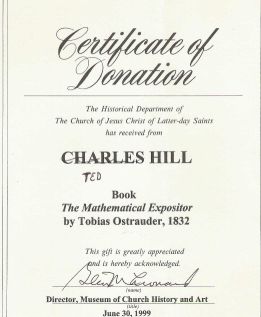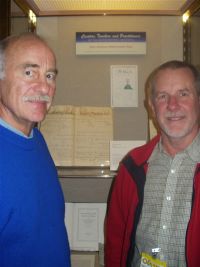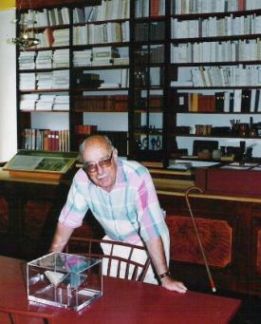 |
|
|
In 2003, Prof. Ted Hill donated approximately 1000 volumes of rare printed books and manuscripts to the Bancroft Library at UC Berkeley. This collection documents the history of arithmetic and mathematics in the United States from the colonial period to the end of the 19th century, and more than half of the texts predate 1850. |
Description of Collection
|
The collection is called the "Theodore P. Hill Collection of Early American Mathematics Books", and consists of approximately 1000 volumes of rare printed books and manuscripts documenting the history of arithmetic and mathematics in the United States from the colonial period to the end of the 19th century. More than half of the texts predate 1850, and many are leather bound. The highlights of the collection include many cornerstone editions – the only known copy of Fenning’s 1789 Ready Reckoner; Chauncy Lee’s 1797 The American Accomptant, with the first appearance of the dollar sign; Daboll’s 1802 Schoolmaster’s Assistant, which presented the first printed instance of the six-percent rule; Farrar’s 1825 Elementary Treatise on Mathematics, a curriculum-altering work; and the first American printing of Newton’s Principia. In addition to these published texts, the collection also includes a number of copybooks (manuscripts written by pupils who could not afford to buy textbooks) of the earliest vintage possible, now seen as valuable not only for being the actual work of pupils in the process of learning, but also as singular works of art. Selected works from the collection were featured in the 2005 Bancroft Library's Exhibit "Creators, Teachers and Practitioners of the Mathematical Sciences". |
Ted Hill with David Farrell, University Archivist, UC Berkeley |
|
To see the Library catalog of the collection: click here for Bancroft Library Oskicat catalog. In the box next to "Keywords" or "Title", enter: Theodore P. Hill Collection of Early American Mathematics Books To contact us, please send email to: losososresearch AT gmail DOT com. To donate books to the collection or to request access for scholarly research, please contact Peter Hanff at the Bancroft Library. |
|
History of Collection
|
In September 1972, Theodore Hill returned from a year as Fulbright Scholar in Germany to begin his PhD in mathematics at the University of California in Berkeley. When he advanced to candidacy two years later, his father Charles J. Hill sent him a copy of an 18th century American mathematics book he had come across in a small bookstore in a village in Upstate New York. Delighted by his son’s appreciation of the gift, the elder Mr. Hill began to collect Early American mathematics books as a hobby, and continued this quest for the remaining three decades of his life. At first Charles worked alone, using spare time during his business travels in New England to browse in antique shops, bookstores, and garage sales. Some treasures he found covered with dust in farmers’ barns, others lay hidden behind modern texts in secondhand stores. He studied restoration techniques, and set up a small shop in his home to temporarily preserve some of the tattered volumes. When he read the advertisement for an estate sale of a Cambridge mathematics professor, he drove 350 miles and bought several hundred old mathematics books sight unseen, later gleaning the windfall for new authors and titles to add to the collection. |
|
Charles Hill with Tobias Ostrander’s The Mathematical Expositor (1832) |
During later years, the elder Mr. Hill employed a museum-quality antiquities bookbinder to restore the most valuable titles, and also employed a rare books dealer to aid him in his search. He himself also began to attend antique and rare books conventions, and during one exposition in Chicago, walked up to the booth of one of the main exhibitors, and asked if they had any early American mathematics books. “Not any that you don’t already have, Mr. Hill,” said the agent, and smiled. |
 |
When Theodore completed his PhD in mathematics at Berkeley in 1977, he accepted a position as assistant professor in the mathematics department at the Georgia Institute of Technology, and at first kept the modest collection in his faculty office. As the collection grew, the Georgia Tech Library advised Dr. Hill of the importance of the books, made him promise to only handle them with clean cotton gloves, and convinced him to house the collection in the climate-controlled vault in the university’s Rare Books Archives. |
|
During the nearly four decades of growth of this collection, only one book was parted with - a 2nd Edition 1832 copy of Tobias Ostrander’s The Mathematical Expositor: Containing Rules, Theorems, Lemmae, and Explanation of the Mathematical Sciences. That book is the only known copy of a text printed by Strong & Grandin Publishers, the first publisher of the Book of Mormon, and was donated to the Mormon Church, where it is now permanently housed in its own display case, and a focal part of the main tour, in the Grandin Building historical museum on East Main Street in Palmyra, New York. Shortly before becoming Professor Emeritus of Mathematics at Georgia Tech, Dr. Hill sought a new home for the collection, in order to increase its access to scholars in history, education and Americana. His three alma maters - West Point, Stanford, and Berkeley - were all natural choices for the collection, but Bancroft Library’s special emphasis in Americana, and the History of Science and Mathematics, put it in first place. Dr. Hill donated the entire collection to Bancroft in 2003, and since then, continued to add to the collection. Just recently, in preparation for this Bancroft exposition, it came to light that many of the early 19th century books in the collection were authored by West Point professors, and were the first calculus textbooks used at UC Berkeley, whose first two professors of mathematics were also West Pointers. |

